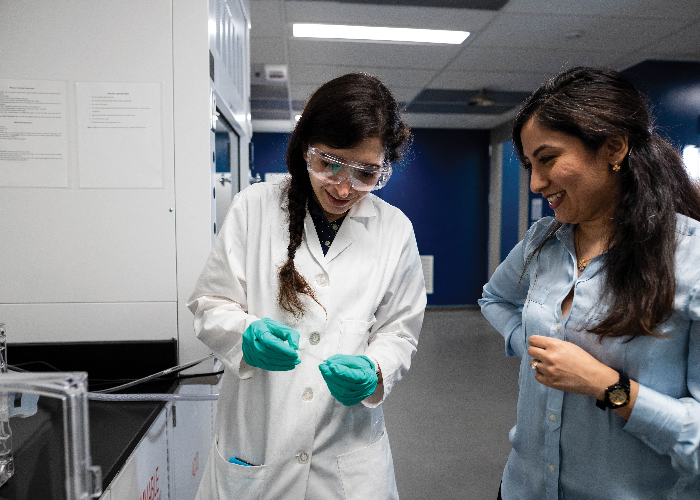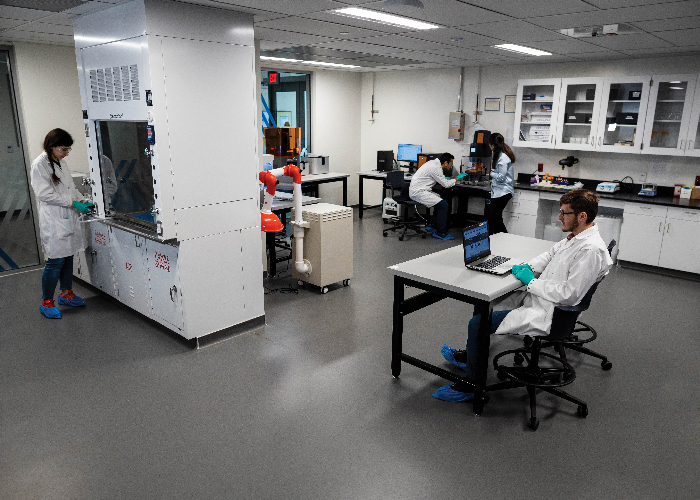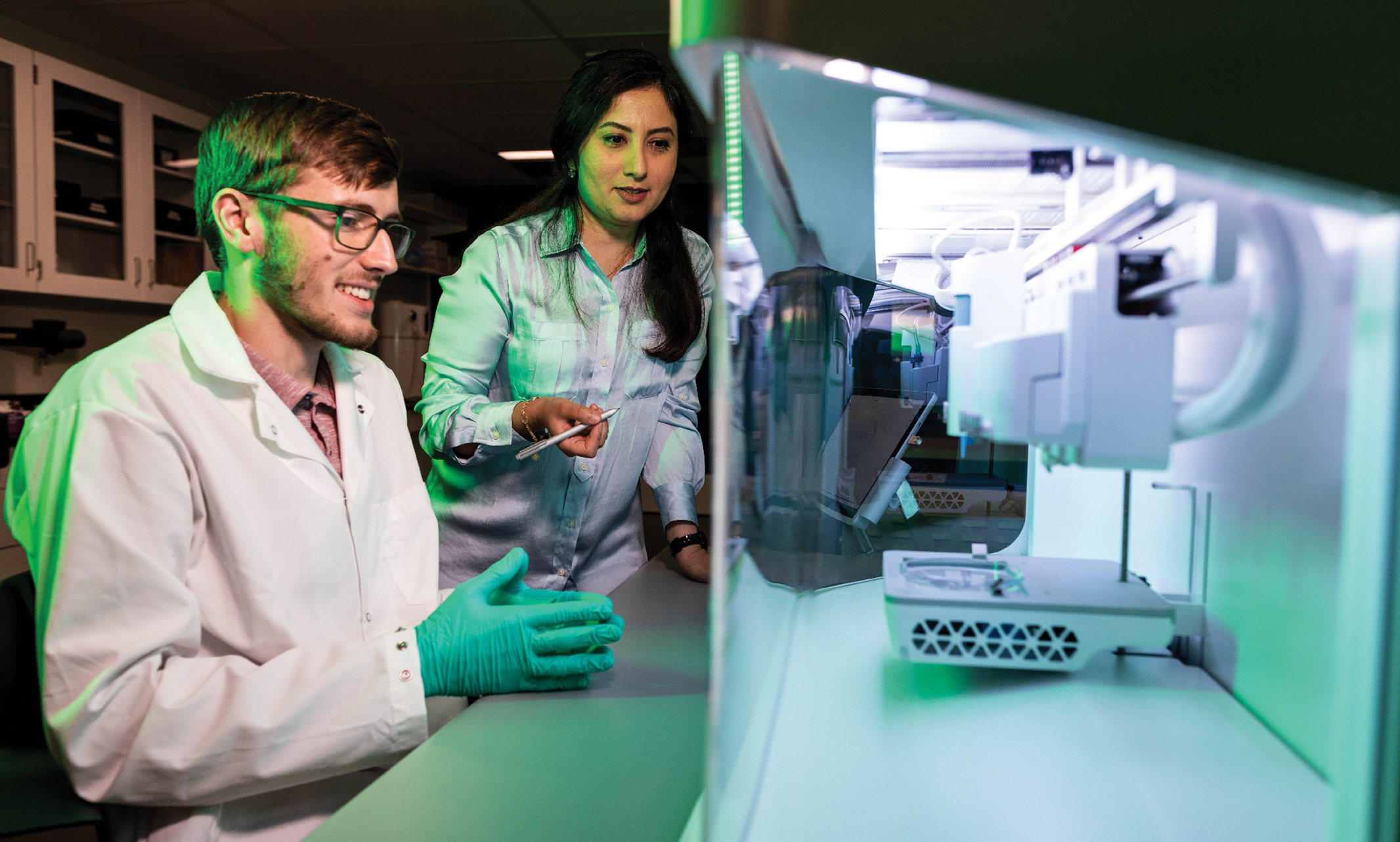When working with bio-and nanomaterials, success can hinge on keeping dust and other impurities out of the process. So for Assistant Professor Zahra Niroobakhsh and her colleagues, it was good news that the Robert W. Plaster Free Enterprise and Research Center would include a top-notch clean room.
“In the past I’ve had to use facilities in Lawrence, Kansas, for some work or order materials from elsewhere to start experiments, which can be very expensive,” says Niroobakhsh, an assistant professor in the Department of Civil and Mechanical Engineering. “But now we have the 3D bioprinters … and the Clean Room, to be able to make everything right here.”

APPLICATIONS ACROSS CAMPUS
For Niroobakhsh, “everything” covers a wide range of research interests and applications. She frequently works with other departments and schools, including chemistry, dentistry, medicine and pharmacy.
Clean Room experiments often involve designing and printing soft nanomaterials, which exist in a state between solid and liquid, then studying how they react and interact in different situations. Because the materials can be designed molecule by molecule, Niroobakhsh and her team can produce the tiny building blocks for all sorts of collaborative research and applications.
In petroleum engineering, for example, the aim can be to improve emulsions used in oil spill cleanup, or to enhance the substances used to recover more oil from a well. In pharmaceuticals, experiments can seek more stable and effective ways to deliver drugs or coat a microchip with a material that can detect virus or disease. And in medicine, the building blocks for cells can be tweaked depending on what is being studied.
Our new printer will allow us to inject six different liquids simultaneously and to switch materials during the print. It also has much higher resolution and other capabilities. We’re very excited!”
Niroobakhsh’s team has worked with Peter Koulen, a professor in the UMKC School of Medicine who has led several groundbreaking research projects at the school’s Vision Research Center.
“Tissues for different parts of the body have different mechanical properties,” Niroobakhsh says. “We can ‘tune’ the biomaterials we are printing so they will produce cells with the properties needed in Dr. Koulen’s work for different parts of the eye.”
As versatile as Niroobakhsh’s work has been already, she’s looking forward to the much more advanced 3D printers available to her in the new Clean Room.
“One of my graduate students built a 3D printer we use,” she says, reflecting the school’s can-do approach. “But our new printer will allow us to inject six different liquids simultaneously and to switch materials during the print. It also has much higher resolution and other capabilities. We’re very excited!”

EMBRACING NEW POSSIBILITIES
Niroobakhsh is used to change and progress. When she joined the faculty in 2018, she brought international experience to the school, having earned her doctorate in materials science and engineering at Penn State, her master’s degree in Germany and her bachelor’s degree in Iran.
She also set right to work establishing her lab, including procuring the right equipment for her work. Niroobakhsh says her rheometer, which measures the flow of most materials, is the only one in the area.
One of her closest collaborators, Stefan Lohfeld, also joined UMKC in 2018 as an assistant professor at the School of Dentistry. They teach the Introduction to Biomaterials course together, using a textbook co-written by UMKC Chancellor C. Mauli Agrawal. They both also utilize bioprinters in their research, and lean on each other for support and perspective. Their printers use different processes, and they often talk about which might be better for a particular task or experiment.
“My printer at SCE uses light to solidify liquid polymers layer by layer to build a device,” Lohfeld says. That Continuous Digital Light Process, or cDLP, “is faster as it manufactures a full layer at a time. This is useful for larger constructs and could be important in mass production. But my printer can’t use multiple materials at once, unlike Dr. Niroobakhsh’s new highend machine.”
Lohfeld has a master’s in production engineering with a focus on materials sciences and his doctorate in materials sciences. He is, essentially, an engineer that works in the School of Dentistry. That works out well, because Sarah Dallas and others at the dental school are leaders in bone-muscle tissue research, and Lohfeld is expert at printing scaffolds on which research cells can grow for tissue engineering.
Lohfeld says the Plaster Center “really gives us access to technologies we haven’t had before, which allows us to expand our research on materials and their processing.”
Besides the research possibilities, Niroobakhsh is eager to have her students see what’s possible from a well-equipped clean room.
“I’m not sure yet how much access there would be for a whole class,” she says. “But the Clean Room’s walls are glass, so we will be able to show students what is being done and explain the processes. … The new facilities will have so many benefits for us.”

